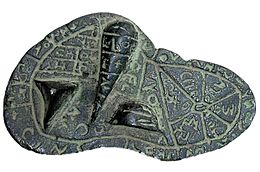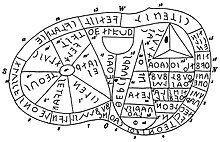Haruspex
| Part of a series on |
| Anthropology of religion |
|---|
 |
| Socialandcultural anthropology |
In thereligion of ancient Rome,aharuspex[a]was a person trained to practise a form ofdivinationcalledharuspicy,[b]the inspection of the entrails[c]ofsacrificed animals,especially theliversof sacrificedsheepandpoultry. Various ancient cultures of the Near East, such as the Babylonians, also read omens specifically from the liver, a practice also known by the Greek termhepatoscopy(alsohepatomancy).
The Roman concept is directly derived fromEtruscan religion,as one of the three branches of thedisciplina Etrusca.Such methods continued to be used well into theMiddle Ages,especially amongChristian apostatesand pagans.
The Latin termsharuspexandharuspicinaare from an archaic word,hīra= "entrails, intestines" (cognate withhernia= "protruding viscera" andhira= "empty gut"; PIE*ǵʰer-) and from the rootspec-= "to watch, observe". The Greek ἡπατοσκοπίαhēpatoskōpiais fromhēpar= "liver" andskop-= "to examine".
Ancient Near East
[edit]
The spread of hepatoscopy is one of the clearest examples of cultural contact in the orientalizing period. It must have been a case of East-West understanding on a relatively high, technical level. The mobility of migrant charismatics is the natural prerequisite for this diffusion, the international role of sought-after specialists, who were, as far as their art was concerned, nevertheless bound to their father-teachers. We cannot expect to find many archaeologically identifiable traces of such people, other than some exceptional instances.
— Walter Burkert,1992.The Orientalizing Revolution: Near Eastern Influence on Greek Culture in the Early Archaic Age(Thames and Hudson), p. 51.
The Babylonians were famous for hepatoscopy. This practice is mentioned in theBook of Ezekiel21:21:
For the king of Babylon standeth at the parting of the way, at the head of the two ways, to use divination; heshaketh the arrowsto and fro, he inquireth of theteraphim,he looketh in the liver.[1][2]
One Babylonian clay model of a sheep's liver, dated between 1900 and 1600 BC, is conserved in theBritish Museum.[3]
The Assyro-Babylonian tradition was also adopted inHittite religion.At least thirty-six liver-models have been excavated atHattusa.Of these, the majority are inscribed in Akkadian, but a few examples also have inscriptions in the nativeHittite language,indicating the adoption of haruspicy as part of the native, vernacular cult.[4]
Ancient Italy
[edit]Roman haruspicy was a form of communication with the gods. Rather than strictly predicting future events, this form of Roman divination allowed humans to discern the attitudes of the gods and react in a way that would maintain harmony between the human and divine worlds (pax deorum).[5]Before taking important actions, especially in battle, Romans conducted animal sacrifices to discover the will of the gods according to the information gathered through reading the animals' entrails.[5]The entrails (most importantly the liver, but also the lungs and heart) contained a large number of signs that indicated the gods' approval or disapproval. These signs could be interpreted according to the appearance of the organs, for example, if the liver was "smooth, shiny and full" or "rough and shrunken".[6]The Etruscans looked for thecaput iocineris,or "head of the liver". It was considered a bad omen if this part was missing from the animal's liver. The haruspex would then study the flat visceral side of the liver after examining thecaput iocineris.[7]


Haruspicy in Ancient Italy originated with the Etruscans. Textual evidence for Etruscan divination comes from an Etruscan inscription: the priest Laris Pulenas' (250–200 BCE) epitaph mentions a book he wrote on haruspicy. A collection of sacred texts called theEtrusca disciplina,written in Etruscan, were essentially guides on different forms of divination, including haruspicy andaugury.[8]In addition, a number of archeological artifacts depict Etruscan haruspicy. These include a bronze mirror with an image of a haruspex dressed in Etruscan priest's clothing, holding a liver while a crowd gathers near him. Another significant artifact relating to haruspicy in Ancient Italy is thePiacenza Liver.This bronze model of a sheep's liver was found by chance by a farmer in 1877. Names of gods are etched into the surface and organized into different sections.[8]Artifacts depicting haruspicy exist from the ancient Roman world as well, such as stone relief carvings located inTrajan's Forum.[6]
Ethiopia and South Sudan
[edit]In southwest Ethiopia and adjacent area ofSouth Sudan,a number of ethnic communities have had the practice of reading animal entrails to divine the future.[9]Some of the groups that have been documented as having this practice includeSuri,Mursi,Topsa,Nyangatom,Didinga,Murle,Me'en,Turkana.
See also
[edit]Notes
[edit]- ^/həˈrʌ.spɛks/hə-RUH-spehks,pluralharuspices/həˈrʌ.spɪˌsiz/hə-RUH-spih-sees,also calledaruspex
- ^/həˈrʌ.spɪˌsiː/hə-RUH-speh-see(L.haruspicina)
- ^exta—hence alsoextispicy(L.extispicium)
References
[edit]- ^"Ezekiel 21".Hebrew Bible in English.Mechon-Mamre.
- ^See also: Darshan, Guy,"The Meaning of bārēʾ (Ez 21,24) and the Prophecy Concerning Nebuchadnezzar at the Crossroads (Ez 21,23-29)",ZAW 128 (2016), 83-95. A more modern translation, from theNew English Bible,translates the verse as follows: "For the king of Babylon stood at the parting of the way, at the head of the two ways, to use divination: he made his arrows bright, he consulted with images, he looked in the liver."New English Bible online
- ^The Liver tablet 92668.
- ^four specimens are known to Güterbock (1987):CTH547 II, KBo 9 67, KBo 25, KUB 4 72 (VAT 8320 inVorderasiatisches Museum Berlin), for which see alsoGeorge Sarton,Ancient Science Through the Golden Age of Greece(1952, 1970),p. 93,citing Alfred Boissier,Mantique babylonienne et mantique hittite(1935).
- ^abJohnston, Sarah Iles. "Divination: Greek and Roman Divination". InEncyclopedia of Religion,2nd ed., edited by Lindsay Jones, 2375–2378. Vol. 4. Detroit, Michigan: Macmillan Reference USA, 2005. Gale eBooks.
- ^abDriediger-Murphy, Lindsay G, and Eidinow, Esther.Ancient Divination and Experience.Oxford: Oxford University Press USA - OSO, 2019.
- ^Stevens, Natalie L. C. “A New Reconstruction of the Etruscan Heaven.” American Journal of Archaeology, vol. 113, no. 2, Archaeological Institute of America, 2009
- ^abMacIntosh Turfa, Jean, and Tambe, Ashwini, eds.The Etruscan World.London: Taylor & Francis Group, 2013. ProQuest Ebook Central.
- ^Abbink, Jon. "Reading the entrails: analysis of an African divination discourse."Man(1993): 705-726.
Bibliography
[edit]- Walter Burkert,1992.The Orientalizing Revolution: Near Eastern Influence on Greek Culture in the Early Archaic Age(Thames and Hudson), pp 46–51.
- Derek Collins, "Mapping the Entrails: The Practice of Greek Hepatoscopy"American Journal of Philology129 [2008]: 319-345
- Marie-Laurence Haack,Les haruspices dans le monde romain(Bordeaux: Ausonius, 2003).
- Hans Gustav Güterbock, 'Hittite liver models' in:Language, Literature and History (FS Reiner)(1987), 147–153, reprinted in Hoffner (ed.)Selected Writings,Assyriological Studies no. 26 (1997).[1]Archived2013-10-29 at theWayback Machine
External links
[edit]- Chisholm, Hugh,ed. (1911)..Encyclopædia Britannica.Vol. 13 (11th ed.). Cambridge University Press. pp. 37–38.This source suggests that Greek and Roman haruspices used the entrails of human corpses; the victim should be "without spot or blemish".
- Haruspices,article in Smith's Dictionary of Greek and Roman Antiquities
- Figurine of Haruspex, 4th Cent. B.C.Vatican Museums Online, Gregorian Etruscan Museum, Room III
- l. Starr (1992). "Chapters 1 and 2 of the bārûtu".State Archives of Assyria Bulletin.6:45–53.


